Python_Statistics&Probability
Posted tlfox_2006
tags:
篇首语:本文由小常识网(cha138.com)小编为大家整理,主要介绍了Python_Statistics&Probability相关的知识,希望对你有一定的参考价值。
python_statistics and probability
https://blog.csdn.net/howhigh/article/details/78007317
https://www.jb51.net/article/152713.htm
常见分布
https://www.jianshu.com/p/c675e3f67843
Python 统计学
https://zhuanlan.zhihu.com/c_178173216
python实现
https://blog.csdn.net/charie411/article/details/100032776
1. 常用的统计分布
用Python统计模拟的方法,介绍四种常用的统计分布,包括离散分布:二项分布和泊松分布,以及连续分布:指数分布和正态分布,最后查看人群的身高和体重数据所符合的分布。
首先导入python相关模块:
import pandas as pd import numpy as np import matplotlib.pyplot as plt import seaborn as sns %matplotlib inline %config InlineBackend.figure_format = \'retina\'
随机数
计算机发明后,便产生了一种全新的解决问题的方式:使用计算机对现实世界进行统计模拟。该方法又称为“蒙特卡洛方法(Monte Carlo method)”,起源于二战时美国研制原子弹的曼哈顿计划,它的发明人中就有大名鼎鼎的冯·诺依曼。蒙特卡洛方法的名字来源也颇为有趣,相传另一位发明者乌拉姆的叔叔经常在摩洛哥的蒙特卡洛赌场输钱,赌博是一场概率的游戏,故而以概率为基础的统计模拟方法就以这一赌城命名了。
使用统计模拟,首先要产生随机数,在Python中,numpy.random 模块提供了丰富的随机数生成函数。比如生成0到1之间的任意随机数:
np.random.random(size=5) # size表示生成随机数的个数
结果:
array([0.12291039, 0.90953163, 0.19120842, 0.14675931, 0.94498984])
又比如生成一定范围内的随机整数:
np.random.randint(1, 10, size=5) # 生成5个1到9之间的随机整数
结果:
array([2, 8, 6, 4, 2])
产生常见分布的随机数:
1) 二项式或贝努力分布:
#np.random np.random.binomial(10,0.5,size = 1000) #scripy.stats stats.binom.rvs(10,0.5,1000)
2) 指数分布
# np.random np.random.exponential(10,size=1000) # scipy.stats stats.expon.rvs(10,size=1000)
3) 均匀分布
# np.random np.random.uniform(-1,1,size=1000) # scipy.ststs stats.uniform.rvs(-1,1,size=1000)
4)正态分布
# np.random np.random.normal(0,1,size=1000) # scipy.stats stats.uniform.rvs(-1,1,size=1000)
PMF&PDF
1) 二项式分布
_lambda = 10.0 # lambda恒等于10,二项分布的试验次数计算每次事件出现的概率p=lambda/n k=np.arange(21) # 正面朝上次数 binom_100 = st.binom.pmf(k,100,_lambda/100) # st.binom.pmf(k,n,p) plt.plot(k,binom_100)
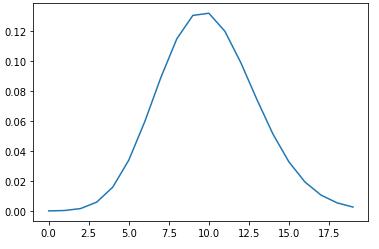
# np.binomial binom_np = np.random.binomial(10,0.5,size=1000) # plot PMF histogram plt.hist(binom_np,bins=50) hist_np = np.histogram(binom_np)[0] plt.plot(hist_np) # plot CDF cdf_np = np.cumsum(hist_np) plt.plot(cdf_np) # st.binom binom_st = st.binom.rvs(10,0.5,size=1000) # plot histogram plt.hist(binom_st,bins=50) hist_st = np.histogram(binom_st)[0] plt.plot(hist_st) # plot CDF cdf_st = np.cumsum(hist_st) plt.plot(cdf_st)
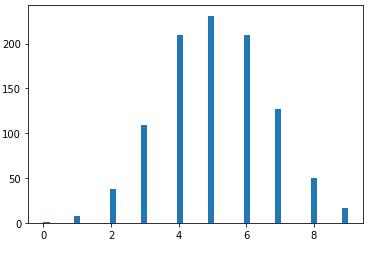
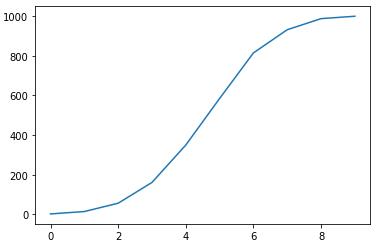
2)泊松分布
#泊松分布:在某段时间范围内,事件发生的次数。 _lambda = 10.0 # 事件平均发生率lambda恒等于10 k = np.arange(20) # 事件发生的次数。 psn = st.poisson.pmf(k,_lambda) # st.poisson.pmf(k,Lambda) plt.plot(k,psn)
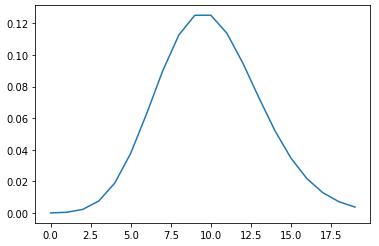
泊松分布与二项分布的关系:当n很大,而p很小时,二项分布可以近似于泊松分布。
3)均匀分布
4)指数分布
5)正态分布
下面介绍使用python生成pdf的方法:
- 使用matplotlib的画图接口plot.hist(),直接画出pdf分布;
- 使用numpy的数据处理函数histogram(),可以生成pdf分布数据,方便进行后续的数据处理,比如进一步生成cdf;
- 使用seaborn的distplot(),好处是可以进行pdf分布的拟合,查看自己数据的分布类型;
 Plot PDF
Plot PDF

arr = np.random.normal(size=100) # plot histogram plt.subplot(221) plt.hist(arr) # obtain histogram data plt.subplot(222) hist, bin_edges = np.histogram(arr) plt.plot(hist) # fit histogram curve plt.subplot(223) sns.distplot(arr, kde=False, fit=stats.gamma, rug=True) plt.show()
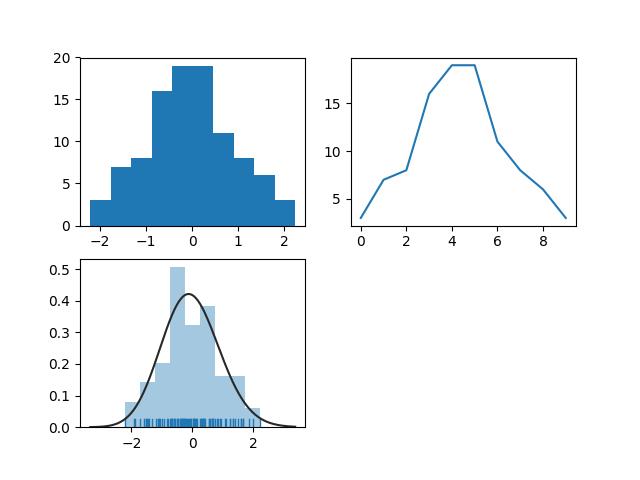
下面介绍使用python生成cdf的方法:
- 使用numpy的数据处理函数histogram(),生成pdf分布数据,进一步生成cdf;
- 使用seaborn的cumfreq(),直接画出cdf;

from scipy import stats import matplotlib.pyplot as plt import numpy as np import seaborn as sns arr = np.random.normal(size=100) plt.subplot(121) hist, bin_edges = np.histogram(arr) cdf = np.cumsum(hist) plt.plot(cdf) plt.subplot(122) cdf = stats.cumfreq(arr) plt.plot(cdf[0]) plt.show()
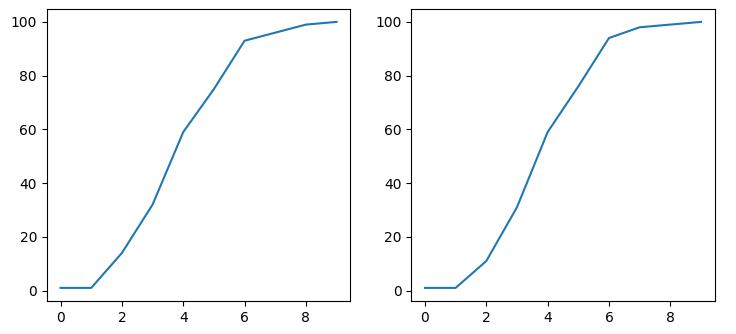
在更多时候,需要把pdf和cdf放在一起,可以更好的显示数据分布。

from scipy import stats import matplotlib.pyplot as plt import numpy as np import seaborn as sns arr = np.random.normal(size=100) hist, bin_edges = np.histogram(arr) width = (bin_edges[1] - bin_edges[0]) * 0.8 plt.bar(bin_edges[1:], hist/max(hist), width=width, color=\'#5B9BD5\') cdf = np.cumsum(hist/sum(hist)) plt.plot(bin_edges[1:], cdf, \'-*\', color=\'#ED7D31\') plt.xlim([-2, 2]) plt.ylim([0, 1]) plt.grid() plt.show()

1) 二项分布
二项分布(伯努利分布)是n个独立的是/非试验中成功的次数的概率分布,其中每次试验的成功概率为p。这是一个离散分布,所以使用概率质量函数(PMF)来表示k次成功的概率:

最常见的二项分布就是投硬币问题了,每次投一个硬币,投n次硬币,正面朝上次数就满足该分布。size(投掷次数)可以从10~10000. 看图形的变化。
sample=np.random.binomial(1,0.5,size=100)
plt.hist(sample,bins=50)
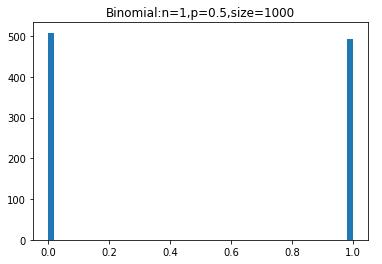
下面我们使用计算机模 拟的方法,产生10000个符合(n,p)的二项分布随机数,相当于进行10000次实验,每次实验投掷了n(10)枚硬币,正面朝上的硬币数就是所产生的随机数。同时使用直方图函数绘制出二项分布的PMF图。

def plot_binomial_PDF(n,p,size): \'\'\'绘制二项分布的概率质量函数\'\'\' sample = np.random.binomial(n,p,size) # 产生10000个符合二项分布的随机数 bins = np.arange(n+2) plt.hist(sample, bins=bins, align=\'left\', normed=True, rwidth=0.1) # 绘制直方图 #设置标题和坐标 plt.title(\'Binomial PMF with n={}, p={}\'.format(n,p)) plt.xlabel(\'number of successes\') plt.ylabel(\'probability\') def plot_binomial_CDF(n,p,size): sample=np.random.binomial(n,p,size) hist,bin_edges=np.histogram(sample) cdf=np.cumsum(hist/sum(hist)) #必须除以sum(hist),才可以归一化。 plt.plot(cdf) plot_binomial_PDF(10, 0.5, 10000) plot_binomial_CDF(10, 0.5, 10000)
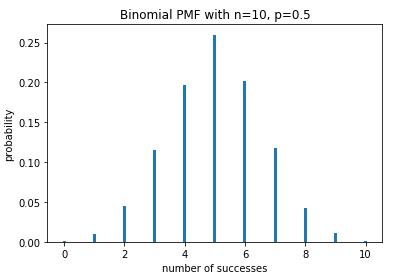
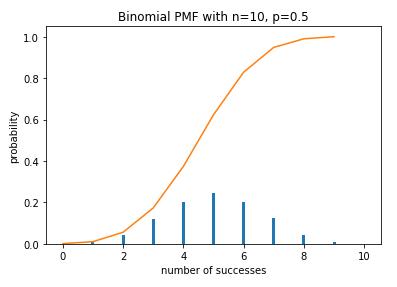
投10枚硬币,如果正面或反面朝上的概率相同,即p=0.5, 那么出现正面次数的分布符合上图所示的二项分布。该分布左右对称,最有可能的情况是正面出现5次。
但如果这是一枚作假的硬币呢?比如正面朝上的概率p=0.2,或者是p=0.8,又会怎样呢?我们依然可以做出该情况下的PMF图。
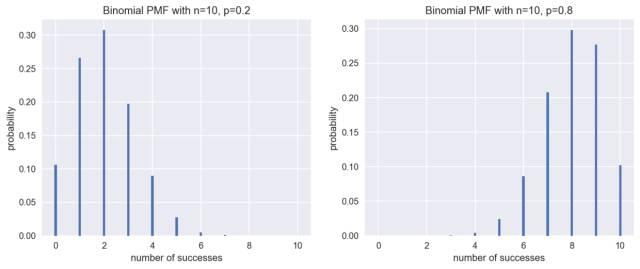
这时的分布不再对称了,正如我们所料,当概率p=0.2时,正面最有可能出现2次;而当p=0.8时,正面最有可能出现8次。
二项分布的例子:抛掷10次硬币,恰好两次正面朝上的概率是多少? - -> k=2, n = 10, p=0.5
-> k=2, n = 10, p=0.5

def binom_pmf(): n = 10 #独立实验次数 p = 0.5 #每次正面朝上概率 k = np.arange(0,11) #0-10次正面朝上概率 binomial = stats.binom.pmf(k,n,p) print(binomial) print(sum(binomial)) print(binomial[2]) plt.plot(k, binomial,\'o-\') plt.title(\'Binomial: n=%i , p=%.2f\' % (n,p),fontsize=15) plt.xlabel(\'Number of successes\') plt.ylabel(\'Probability of success\',fontsize=15) plt.show()

[0.00097656 0.00976563 0.04394531 0.1171875 0.20507813 0.24609375
0.20507813 0.1171875 0.04394531 0.00976563 0.00097656]
1.0000000000000009
0.04394531249999999
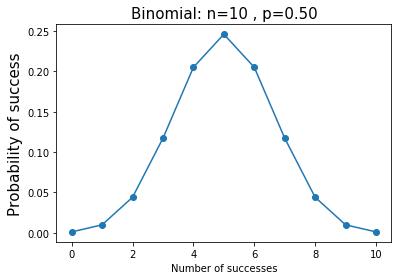
2) 泊松分布
泊松分布用于描述单位时间内随机事件发生次数的概率分布,它也是离散分布,其概率质量函数PMF为:

比如你在等公交车,假设这些公交车的到来是独立且随机的(当然这不是现实),前后车之间没有关系,那么在1小时中到来的公交车数量就符合泊松分布。同样使用统计模拟的方法绘制该泊松分布,这里假设每小时平均来6辆车(即上述公式中lambda=6)。

lamb = 6 sample = np.random.poisson(lamb, size=10000) # 生成10000个符合泊松分布的随机数 bins = np.arange(20) plt.hist(sample, bins=bins, align=\'left\', rwidth=0.1, normed=True) # 绘制直方图# 设置标题和坐标轴 plt.title(\'Poisson PMF (lambda=6)\') plt.xlabel(\'number of arrivals\') plt.ylabel(\'probability\') plt.show()

根据图示,你会发现,泊松分布像正态分布,且λ=6的数据比较多。

from scipy import stats import matplotlib.pyplot as plt import numpy as np import seaborn as sns arr = np.random.POISSON(5,size=100) hist, bin_edges = np.histogram(arr) width = (bin_edges[1] - bin_edges[0]) * 0.8 plt.bar(bin_edges[1:], hist/max(hist), width=width, color=\'#5B9BD5\') cdf = np.cumsum(hist/sum(hist)) plt.plot(bin_edges[1:], cdf, \'-*\', color=\'#ED7D31\') plt.title("Poisson PMF&CDF") plt.xlabel("number of arrives") plt.ylabel("probability")
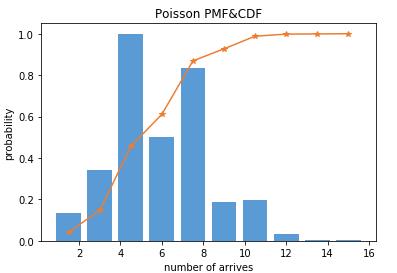
二项分布的近似分布泊松分布
程序分别计算二项分布和泊松分布的概率质量函数,当n足够大时,二者是十分接近的。
程序中事件平均发生率lambda恒等于10。根据二项分布的试验次数计算每次事件出现的概率p=lambda/n。lambda = np

_lambda = 10.0 k = np.arange(20) possion = stats .poisson .pmf(k, _lambda) # 泊松分布 binom100 = stats.binom.pmf(k, 100, _lambda/100) #二项式分布 100 binom1000=stats.binom.pmf(k, 1000 , _lambda/1000) #二项式分布 1000 plt.figure(num=3,figsize=(8,5)) plt.plot(stats .poisson .pmf(k, _lambda),\'b\') plt.plot(stats.binom.pmf(k,100,_lambda/100),\'r\') plt.plot(stats.binom.pmf(k,1000,_lambda/1000),\'y\') plt.legend([\'possion\',\'binom_100\',\'binom_1000\'])
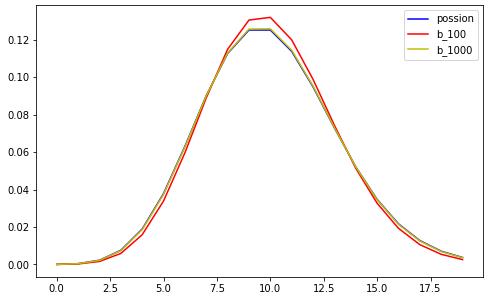
3)均匀分布

from scipy import stats import matplotlib.pyplot as plt import numpy as np arr = np.random.uniform(-2,2,1000) hist, bin_edges = np.histogram(arr) width = (bin_edges[1] - bin_edges[0]) * 0.8 plt.bar(bin_edges[1:], hist/max(hist), width=width, color=\'#5B9BD5\') cdf = np.cumsum(hist/sum(hist)) plt.plot(bin_edges[1:], cdf, \'-*\', color=\'#ED7D31\') plt.title("Uniform PMF&CDF") plt.xlabel("number of arrives") plt.ylabel("probability") plt.xlim([-2,2]) plt.ylim([0,1])
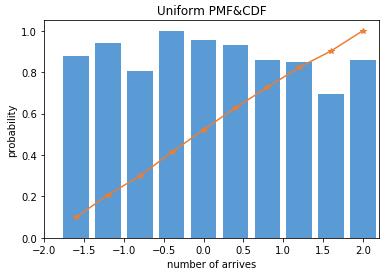
4) 指数分布
指数分布用以描述独立随机事件发生的时间间隔,这是一个连续分布,所以用质量密度函数表示:

比如上面等公交车的例子,两辆车到来的时间间隔,就符合指数分布。假设平均间隔为10分钟(即1/lambda=10),那么从上次发车开始,你等车的时间就满足下图所示的指数分布。
tau = 10 sample = np.random.exponential(tau, size=10000) # 产生10000个满足指数分布的随机数 plt.hist(sample, bins=80, alpha=0.7, normed=True) #绘制直方图 plt.margins(0.02) # 根据公式绘制指数分布的概率密度函数 lam = 1 / tau x = np.arange(0,80,0.1) y = lam * np.exp(- lam * x) plt.plot(x,y,color=\'orange\', lw=3)#设置标题和坐标轴 plt.title(\'Exponential distribution, 1/lambda=10\') plt.xlabel(\'time\') plt.ylabel(\'PDF\') plt.show()

Exponential PDF&CDF:

from scipy import stats import matplotlib.pyplot as plt import numpy as np arr = np.random.exponential(10,1000) #PDF hist, bin_edges = np.histogram(arr) width = (bin_edges[1] - bin_edges[0]) * 0.8 plt.bar(bin_edges[1:], hist/max(hist), width=width, color=\'#5B9BD5\') #CDF cdf = np.cumsum(hist/sum(hist)) plt.plot(bin_edges[1:], cdf, \'-*\', color=\'#ED7D31\') plt.title("Exponetial PMF&CDF") plt.xlabel("Time") plt.ylabel("probability") plt.xlim([0,100]) plt.ylim([0,1])
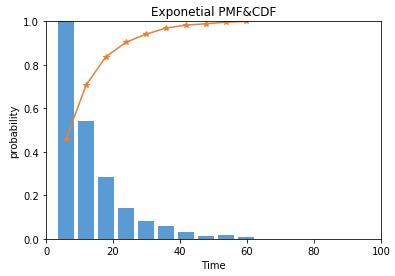
5) 正态分布
正态分布是一种很常用的统计分布,可以描述现实世界的诸多事物,具备非常漂亮的性质,其概率密度函数为

以下绘制了均值为0,标准差为1的正态分布的概率密度曲线,其形状好似一口倒扣的钟,因此也称钟形曲线
def norm_pdf(x,mu,sigma): \'\'\'正态分布概率密度函数\'\'\' pdf = np.exp(-((x - mu)**2) / (2* sigma**2)) / (sigma * np.sqrt(2*np.pi)) return pdf mu = 0 # 均值为0 sigma = 1 # 标准差为1 # 用统计模拟绘制正态分布的直方图 sample = np.random.normal(mu, sigma, size=10000) plt. hist(sample, bins=100, alpha=0.7, normed=True)# 根据正态分布的公式绘制PDF曲线 x = np.arange(-5, 5, 0.01) y = norm_pdf(x, mu, sigma) plt.plot(x,y, color=\'orange\', lw=3) plt.show()
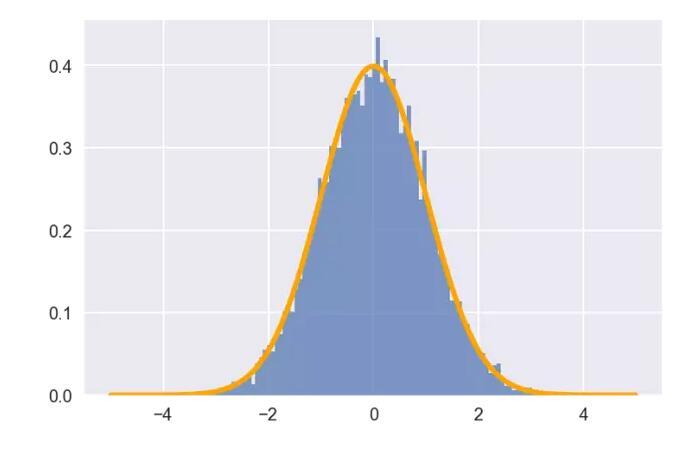
Normal PDF&CDF

from scipy import stats import matplotlib.pyplot as plt import numpy as np arr = np.random.normal(0,1,10000) #PDF hist, bin_edges = np.histogram(arr) width = (bin_edges[1] - bin_edges[0]) * 0.6 plt.bar(bin_edges[1:], hist/max(hist), width=width, color=\'#5B9BD5\') #CDF cdf = np.cumsum(hist/sum(hist)) plt.plot(bin_edges[1:], cdf, \'-*\', color=\'#ED7D31\') plt.title("Normal PMF&CDF") plt.xlim([-4,4]) plt.ylim([0,1])
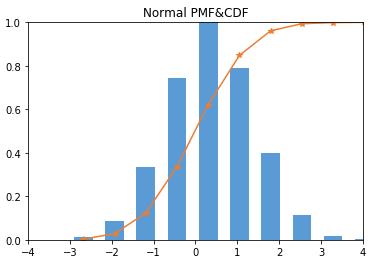
假设检验,亦称显著性检验,是利用样本信息,根据一定的概率水准,推断指标(统计量)与总体指标(参数)、不同样本指标间的差别有无意义的统计分析方法。
参数检验:是依赖总体分布的具体形式的统计方法,简称参数法。常用的参数法有X2检验、t检验、F检验等。使用条件是抽样总体的分布已知。
- 优点:能充分利用样本信息;检验效率高
- 缺点:应用条件限制较多;手工计算较繁琐。
非参数检验:是一类不依赖总体分布的具体形式的统计方法。如Ridit分析、秩和检验、符号检验、中位数检验、序贯试验、等级相关分析等。
- 优点:对总体的分布形式不要求;可用于不能精确测量的资料;易于理解和掌握;计算简便。
- 缺点:不能充分利用资料所提供的信息,是检验效率降低。
卡方分布
https://www.cnblogs.com/Yuanjing-Liu/p/9252844.html
https://zhuanlan.zhihu.com/p/36351919
理论:
https://wenku.baidu.com/view/3931858f53ea551810a6f524ccbff121dd36c5e0.html
公式:ΣX2,多个正态分布的平方和,其自由度是n-1个正态分布平方相加。
应用:分类的关联性,即是否独立
卡方分布python实现:
https://blog.csdn.net/charie411/article/details/99962293
T分布
理论:
https://wenku.baidu.com/view/1ea79dfddd88d0d233d46ab3.html
https://wenku.baidu.com/view/0dac87170b4e767f5acfcee6.html?sxts=1566439275597
基本思想:样本均值与与已知的总体均值比较。
T检验python实现:
https://blog.csdn.net/charie411/article/details/100009024
https://mp.weixin.qq.com/s/sv5QipNA6QPWgDC3R8DuAQ
T检验的应用:
单样本T检验:用于样本均数与已知总体均数的比较。此时,总体均数认为是已知的。
配对样本T检验:配对设计:是将观察单位按照某些特征(如性别、年龄、病情等可疑混杂因素)配成条件相同或相似的对子,每对中的两个观察单位随机分配到两个组,给与不同的处理,观察指标的变化
以上是关于Python_Statistics&Probability的主要内容,如果未能解决你的问题,请参考以下文章
